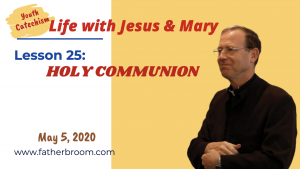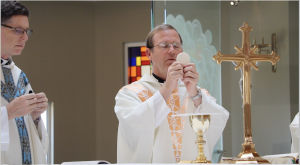
Lesson 25: Holy Communion
1.What is Holy Communion?
Holy Communion is the Body, Blood, Soul, and Divinity of Jesus Christ. Holy Communion is Jesus, who is loving us.
Holy Communion is the greatest of all the 7 Sacraments, because it is Jesus Himself. It is the “Sacrament of sacraments.”
2. When do the bread and wine become the body, blood, soul and divinity of Jesus?
Bread and wine become Jesus at the “Consecration” during the Mass.
At the first part of the Consecration the priest says, “This is my body.” At this moment the bread becomes Jesus. It still looks and tastes like bread, but it is no longer bread. It is Jesus.
At the second part of the Consecration the priests takes the cup and says, “This is the cup of my blood.” At this moment the wine becomes Jesus. It still looks and tastes like wine, but it is no longer wine. It is now Jesus.
3. Why does Jesus make Himself look and tates like bread?
Jesus makes Himself looks like bread so that we can receive Him in Holy Communion. He loves us so much that H wants to come into our hearts.
 4. Do we see Jesus in the Holy Eucharist?
4. Do we see Jesus in the Holy Eucharist?
No, we do not see Jesus in the Holy Eucharist.
Holy Communion still looks like bread. It stiall tates and feels like bread. But it is no longer bread. It is Jesus.
We do not say that Jesus is in the bread. The bread no longer exists. All that exists is Jesus, who is present under the appearance of bread.
Each Host, even the smallest piece, is Jesus. When we break the Host into pieces, each part of Jesus, who is wholly present.
We believe that He is there, because Jesus told us that He is.
5. What must we do to receive Holy Communion worthily?
To receive Holy Communion worthily we must do the following.
a. We must have our souls free from mortal sin.
People in mortal sin may not go to Holy Communion without first having gone to confession. It is a mortal sin if they receive Holy Communion with mortal sin. This mortal sin is called a SACRILEGE.
People in the state of venial sin can go without having first gone to Confession. Venial sin makes the soul sick. Sick people need to eat. We can receive Communion with venial sins. But first we should be sorry for our sins. If we are able to receive Holy Communion and we do not receive Him, Jesus is hurt.
b. We must not eat or drink anything for one hour before Holy Communion. Water and medicine may be taken at any time before Holy Communion. Not eating is a way of sowing Jesus that we are sorry for our sins. People who are elderly or sick do not have to observe the one hour fast. Those who are visiting the elderly or the sick do not have to observe the one hour fast, if they received with the sick person.
If you ate something right before Mass, any priest in the Archdiocese of Los Angeles can you a dispensation from the hour fast.
c. We must receive Jesus with faith and love; and not just out of routine.
6. How often can we receive Holy Communion in one day?We can receive Holy Communion two times a day, if the second time we receive Him is in the Mass.
7. What should we do right before receiving Holy Communion?
- Tell Jesus that you are sorry for your sins.
- Ask Mary to prepare your soul to receive Jesus well: “Mary, make my soul a heaven to receive Jesus well. Mary, give me your heart to receive Jesus well.”
- Tell Jesus that you long to receive Him: “Jesus I thirst for You.”
8. What should you do immediately after Holy Communion?
After Holy Communion you should speak and listen to Jesus with much love.
- Ask Jesus to totally take over your life – through Mary.
- Believe in Jesus. Adore Jesus. Trust in Jesus. Love Jesus. Thank Jesus.
- Ask Jesus to make you a saint.
- Pray for others.
9. What is done with the Hosts (Jesus) that are not received in Holy Communion?
We place the extra Hosts (Jesus) in the tabernacle. The red candle burning in the Church is the sign that Jesus is present in the tabernacle.
HE remains in the tabernacle in Church.
He is there waiting for us to visit Him. HE loves us.
He wants to give us many blessings when we visit Him.
He is happy when we visit Him.
Whenever we enter or leave the Church, or pass in front of the tabernacle we make a genuflection. We genuflect on the right knee to show Jesus that we love Him. We genuflect before Jesus because He is God.
10. What is a monstrance?
Outside of Mass we also place Jesus in a monstrance so that we can see Him. We love, worship, and pray to Him. By being there we console Him. He is hurt that many people never visit Him. Many people do not love Him in return. He desires to bless us and give us many beautiful gifts, but He cannot do so, if we do not receive Him in Holy Communion and we do not visit Him. When we visit Him, He blesses us and answers our prayers. HE gives us his love and peace.
The Sacred Heart of Jesus
Jesus revealed to St. Margaret Mary (1647-1690) his Sacred Heart. His Heart and the flames show how much He loves us in the Eucharist. His Heart is crowned with thorns because Jesus is hurt in the Eucharist. He is hurt because so many people never visit Him present in the Tabernacle. He is hurt because many people do no receive Him well in Holy Communion, or worse they receive Him with mortal sins n their souls. Many people come to church and never pay attention to Him. They are ungrateful and cold. When we visit Him and receive Him well in Holy Communion, we console his Sacred Heart. When we tell Him that we love Him, we console His Heart. When we love Him for those who do not love Him, He will lead us to a deeper friendship with Him.
“These things are warnings for us” (1 Corinthians 10:6)
When the Communist came to power in North Vietnam, a group of Communist soldiers entered by force into a convent of nuns. They want to kick the nuns out and change the convent into a place for the soldiers to live. The Mother Superior told the soldiers that they had to leave.
“Please leave us alone,” she said. “We have the King of kings living with us in our chapel. Jesus is alive here, and because of that we will not give up this building.” The sergeant in the group said scornfully, “Where is this King of kings, this Jesus, you talk about?”
The Mother Superior took him to the chapel and pointed to the tabernacle. The sergeant picked up a rifle, aimed it, and shot directly into the tabernacle. The echo of that shot had not disappeared before the sergeant who fired the shot was dead of a heart attack on the chapel floor.
Venerable Zepherin Namuncura (1886-1905)
Zepherin was an Araucano Indin who lived in Argentine. When he was 11 years old his father sent him to a military school. There at the school Zepherin suffered very much. The other white children made fun of him because he was an Indian. He was so unhappy there that he became ill. A priest, who knew him, had him transferred to a Catholic school in Buenos Aires. There at school he was able to make friends.
There he also made his First Communion, which was a very special day for him. His love for Jesus in the Eucharist began to grow deeply. One day during class one of his teachers saw that he was often looking out the door of the classroom. Nonetheless every time he asked Zepherin a question on what he had been talking about, Zepherin answered correctly. He was paying attention. The teacher, seeing that he continued to look out the door into the corridor asked him after class why he kept doing that. Zepherin responded that he was able to see the red candle next to the tabernacle from there. It helped him to be constantly focused on loving Jesus. He was able to do that and pay attention to class at the same time. His teacher was deeply touched by that, and let him continue. This prayer changed Zepherin’s heart. His heart became even better.
Zepherin entered the seminary. He wanted to be a priest. He worked so hard at this studies that he was second in his class. He was often seen praying in front of the Blessed Sacrament and saying the rosary. When asked why he was praying, he always responded, “I am praying for my people.”
Zepherin contracted tuberculosis, the disease that killed many Araucano Indians. The hospital chaplain said of him: “We thought he lived in continual prayer. He never gave signs of impatience or disgust. Grateful for any service, he smiled his thanks to all and obeyed every order given him.” He bore his sufferings heroically, constantly praying the rosary for his people, until his peaceful death on May 11, 1905.